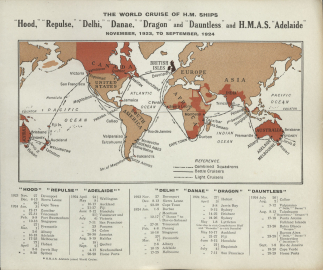British Special Service Squadron - 27th November
- View news filtered by: Interwar
- View news filtered by: Navy Organisation
- View news filtered by: Specialisms
- View news filtered by: Units & Squadrons
- View news filtered by: British Special Service Squadron
- View news filtered by type: Blog

‘27th November 1923. Got underway at 0945, started World Cruise, not touching at Plymouth.’
This simple entry from the private diary of William Bishop onboard HMS Danae belies the large-scale political, diplomatic and naval exercise known as the British Special Services Squadron Cruise, also known as the Empire Cruise. This cruise, which took place from 1923-1924 covered 38,152 miles, and was overseen by Vice-Admiral Sir Fredrick Field.
The ships taking part were the Battlecruisers HMS Hood (flagship)and HMS Repulse; with the 1st Light Cruiser Squadron (HMS Danae, HMS Dauntless, HMS Delhi, HMS Dragon and HMS Dunedin. His Majesty’s Australian Ship (HMAS) Adelaide also joined the Squadron for the remainder of the cruise at Sydney and was the first Royal Australian Navy ship to pass through the Panama Canal.
This cruise was not only a promotion of the power of the Royal Navy but a demonstration of its post-war logistical capabilities. Five years after the First World War, there was a political feeling that if the British Empire was to continue and prosper, its dominions and colonies needed to work together in peace, as well as in war.
After the expense of the First World War, the Royal Navy had demobilized (reduced) to peacetime levels and in 1919, the Treasury introduced the Ten-Year Rule – not to plan for a major threat to the British Empire for at least 10 years. There were several conferences after the war to negotiate international policy and naval power; one of these was The Imperial Conference (1921) and another was The Washington Conference (1921-1922).
The Imperial Conference aimed to unify international policy, but the key outcome was the non-renewal of the Anglo-Japanese Alliance. Japan had given support to the British during the First World War under the arrangement and both Australia and New Zealand wanted it to be renewed. The United States of America was concerned about Japanese political intentions and Canada, being mindful of their American neighbours, did not back it. The alliance ceased in 1923 and left the British without an independent ally in the Pacific. The later Washington conference concluded with several signed agreements including the Five-Power Naval Limitation Treaty. This impacted the Royal Navy most by limiting the numbers and size (tonnage) of capital ships it could maintain. Article XIX of the Treaty was to maintain the status quo regarding fortifications and naval bases.
Following this the Rt. Hon. Leopold Amery, MP, First Lord of the Admiralty wrote a set of brief considerations in April 1923. These included following up any agreements for co-operation at the Imperial Conference, allowing local forces to have the opportunity of doing joint exercises, and to give the Royal Navy more experience of long-distance cruises.
The cruise was therefore born, and to the average sailor in the Royal Navy presented an opportunity ‘to meet our kinsmen overseas, to carry to them a message of peace and goodwill and to revive in their hearts and in ours the ties that bind them to us, and us to them.’ (Scott O’Connor, 1925).
Part ceremonial, it was also a sporting, recreational and sightseeing spectacular. Outward bound, the route was to take them to:
Sierra Leone, Cape Town, East London, Durban, Kilindini and Mombasa, Zanzibar, Trincomalee (Ceylon, now Sri Lanka ), Port Klang (Port Swettenham) Malaysia; Indonesia: Singapore, Christmas Island; Australia: Fremantle, Albany, Adelaide, Melbourne, Hobart (Tazmania), Jervis Bay, Sydney, Brisbane ; New Zealand: Lyttleton (Christchurch), Dunedin and Bluff (HMSs Dunedin and Dauntless), Napier (HMS Delhi, Danae and Dragon and HMAS Adelaide), Gisborne, Wellington, Auckland; Pacific: Suva (Fiji), Honolulu (Hawaii); Canada (Western coast): Victoria (BC), Vancouver, Esquimalt (1st Light Cruiser Squadron); United States (Western coast) and San Francisco.
The British Empire was changing, however. Even before the ships had departed, the 1923 Imperial Conference met in London, principally concerned the rights of the Dominions in determining their own foreign policy and preferential trade agreements. It was a move towards a voluntary British Commonwealth but lacked equal recognition for individuals.
However, the cruise did go ahead and left with an un-auspicious start with the weather being dismal and the cruisers being slightly delayed in port by fog. On the centenary of the start of this monumental cruise The National Museum of the Royal Navy will start a journey of using our related collections from this cruise to explore complex narratives around the British Empire and the Royal Navy’s involvement in it. Come back regularly for further discussion and collection highlights on our portal.
References
ADM116/2219; ADM116/2220. Empire Cruise - Special Service Squadron, The National Archives.
Hurd, Archibald. Empire Naval Defence The Argus (Melbourne, Vic. : 1848 - 1957) Sat 18 Mar 1922. Page 4
Redford, Duncan. Collective Security and Internal Dissent: The Navy League's Attempts to Develop a New Policy towards British Naval Power between 1919 and the 1922 Washington Naval Treaty. History Vol. 96, No. 1 (321) (JANUARY 2011), pp. 48-67
Scott O'Connor, Vincent Clarence. The Empire cruise. Riddle, Smith & Duffus, 1925
RMM 2015/50/1 diary of Bugler R Newman, HMS Repulse
RNM 1987/497/26. Private diary kept by William Bishop of the commission of HMS Danae
RNM 2015/175/1 Scrapbooks of Charles Round-Turner
Vinson, J.C. 'The Imperial Conference of 1921 and the Anglo-Japanese Alliance', Pacific Historical Review, vol. XXXI (August 1962)